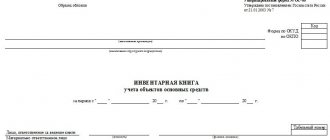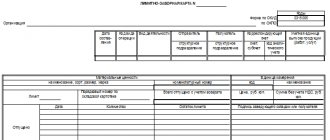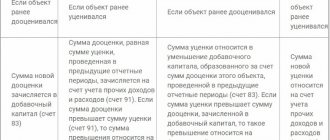The role of depreciation of fixed assets in the activities of an enterprise
As is known, depreciation of fixed assets represents the cost of fixed assets, gradually distributed among the cost of production, manufactured goods and services provided. This implies the gradual accumulation in a specialized fund of funds received as a result of the sale of goods produced or services provided. These funds can be used as investments and, as a rule, they are: depreciation charges in many companies range from 70 to 80% of all investment funds, since their use is more profitable than third-party investment.
This investment can be used for the following needs:
- Purchasing new equipment instead of worn-out and retired equipment;
- Carrying out major repairs of equipment;
- Modernization of production;
- Reconstruction of structures;
- Technical re-equipment.
Accounting for depreciation of fixed assets
Accounting for depreciation of fixed assets is carried out in accordance with Accounting Rules 6/01. Maintaining such records is necessary so that at any time you can find out the level of depreciation of a fixed asset or its residual value. The calculation and distribution of depreciation payments is carried out by the organization's employees and is carried out in the manner established by the accounting policy of the enterprise. Various forms can be used for this, both recommended by legislative bodies and those developed independently.
Fixed Asset Accounting Form
Most often, to account for depreciation of fixed assets, various types of enterprises use documents such as statements of depreciation of fixed assets in form No. B-1.
Important ! According to Article 314 of the Tax Code of the Russian Federation, employees of the accounting service of an enterprise can also develop their own form of accounting depreciation sheet . However, in this case, you should follow the recommendations of the Ministry of Finance on the approximate composition of the details of each section.
In this article, we will consider the most commonly used form of statement - form No. B-1 , developed for small enterprises.
Despite the fact that the form is intended for small organizations, it can also be adapted for use in manufacturing companies with a large production volume.
Order of the Ministry of Finance of the Russian Federation dated September 23, 2005 No. 123n
Budget accounting registers are designed to systematize and accumulate information contained in primary documents accepted for accounting. Budget accounting register forms are unified document forms (UFD) and contain the names of details and indicators and their corresponding codes according to all-Russian classifiers and classifications necessary for automated information processing. Unified document forms consist of three parts: header, content and design.
The header part of the document forms contains the following details:
name of the document form;
document code according to the All-Russian Classifier of Management Documentation (OKUD);
the date on which the information contained in the document was presented;
name of the institution that compiled the document and code according to the All-Russian Classifier of Enterprises and Organizations (OKPO);
name of the structural unit of the institution in which the document was generated;
name of the unit of measurement and code according to the All-Russian Classifier of Units of Measurement (OKEY).
In addition to the details common to document forms, additional details specific to a specific document can be provided (for example, approval stamp, name of the main manager of funds from the federal budget according to the list of direct recipients (DRP) of the budget classification of the Russian Federation, frequency, name of the debtor (creditor), type borrowing, the name of the object of fixed assets according to the All-Russian Classifier of Fixed Assets (OKOF), for the name of the currency according to the All-Russian Classifier of Currencies (OKV), etc.)
The content of the document form is presented in a table containing the names of indicators, and, if necessary, indicator codes for the corresponding classifiers and classifications.
The formal part of the document form is intended to give the document legal force and contains the signatures (with transcript) of officials responsible for the data contained in the document, the date of signing the document. In addition, the position of the performer, signature (with transcript), and contact phone number must be indicated.
When maintaining accounting books, the sheets of the book must be laced and numbered, the number of sheets must be certified by the head of the institution and the chief accountant and sealed with the seal of the institution.
Under the condition of automated maintenance of accounting books, the numbering of the sheets of the book is carried out automatically in ascending order from the moment the book is opened. The pages of the book printed on paper are bound in chronological order. The total number of sheets for the year is certified by the signatures of the head and chief accountant of the institution, and the book is sealed.
To reflect the specifics of an institution's budget accounting, it is possible to enter additional details and indicators into the budget accounting registers, subject to the availability of mandatory details and indicators determined by the Instructions for Budget Accounting, approved by Order of the Ministry of Finance of the Russian Federation dated August 26, 2004 No. 70n.
Removing individual details from budget accounting registers is not allowed.
The formats of budget accounting registers are advisory in nature and, if necessary, can be changed.
When producing blank products based on unified forms of budget accounting registers, it is permissible to change (narrow, expand) the sizes of columns and lines, taking into account the significance of the indicators, as well as the inclusion of additional lines and the creation of loose-leaf sheets for ease of placement and processing of information.
Purpose of depreciation sheet B-1
Statement B-1 is used to document the decrease in the tax base for the reporting period. It also reflects the cost of fixed assets per month or per year. Form B-1 allows you to track changes in the cost of structures, buildings or some equipment over a certain period.
Thus, the depreciation sheet for fixed assets performs the following tasks assigned to it:
- Reflection of the disposal of fixed assets from circulation;
- Reflection of the modernization of means of production;
- Reflection of costs incurred for modernization;
- Reflection of the movement of OS used in production;
- Reflection of depreciation accrual over a certain period.
General presentation of the balance sheet for account 01
This register reflects information about the initial cost of fixed assets: at the beginning of the period, turnover and final balance. The balance at the beginning and end of the period can only be debit or absent. The balance is reflected in the “Balance/debit” column of the statement. This is explained by the fact that account 01 is active, and the balance on it is exclusively debit.
You can see an example of filling out a balance sheet (hereinafter referred to as TSA) for account 01 on our website:
Analytics in the register can be presented in groups and separately for each fixed asset object - for modern accounting software, presenting such detail is not a problem.
The need for analytics by groups follows from the requirements of paragraph. 2 clause 32 of PBU 6/01, which provides for the disclosure of data in the financial statements on the initial cost of groups of fixed assets. Organizations must determine the grouping of objects independently.
In order to bring accounting and tax accounting closer together, it is permissible to take as a basis the classification approved by Decree of the Government of the Russian Federation dated January 1, 2002 No. 1. This classification provides for the grouping of objects based on the “life of use” criterion.
Turnover for the period shows the change in the original cost of fixed assets. An increase in the initial cost of fixed assets in accounting - turnover on the SALT debit - can occur in the following cases (clause 14 of PBU 6/01):
- commissioning of a new facility;
For information on the preparation of the primary document for such an operation, see the material “Unified Form No. OS-1 - Certificate of Acceptance and Transfer of Assets”.
- completion, retrofitting, reconstruction, OS modernization,
- re-evaluation of the OS.
A decrease in the initial cost of fixed assets in accounting is reflected in the turnover on the SALT loan and can occur as a result (clause 14 of PBU 6/01):
For information on drawing up the primary document for fixed assets that have fallen into disrepair, see the material “Unified Form No. OS-4 - Act on the write-off of an asset.”
- partial liquidation of OS;
- OS revaluation.
The total on the statement in the column “Balance at the end of the period/debit”, minus the credit balance on account 02 “Depreciation of fixed assets”, is reflected in the balance sheet line “Fixed assets” in section I “Non-current assets”.
The procedure for filling out the OS accounting sheet
The document in Form B-1 must be completed monthly . In this case, every month a new clean sheet is used, and the total for the previous month is entered into it.
In order to correctly draw up a depreciation statement in Form No. B-1, the following points should be taken into account:
- This document is divided into two parts: information on account 01, where fixed assets are recorded, and information on account 02, where depreciation is reflected.
- OS is reflected in groups, information for which is indicated separately.
The following information is reflected in the fixed assets account:
- OS name;
- Its inventory number;
- Cost of the OS object;
- Object status;
- Its location.
Important! It should be taken into account that fixed assets subject to transfer for use to other production companies, as well as depreciation on them, must be taken into account in a separate statement.
Account section 02 requires indicating the facts of calculation and calculation of depreciation of fixed assets. In this case, the following indicators are important:
- The amount of deductions per unit of time (for 1 month, since this is the frequency of updating this document);
- Category of operation of the fixed asset. This value should determine the period for calculating depreciation of the equipment, that is, over what period the wear and tear of this OS will occur.
- The total amount of depreciation. Indicated in monetary terms.
- The volume and amount of accrued depreciation for the specified period. This value directly affects the residual value of the depreciation item.
- The cost of the fixed asset. The remaining value of the object is indicated after deduction of depreciation charges from the original cost.
Based on the calculation results, under each column of the table, the total value is displayed for each group of fixed assets. The information obtained allows us to objectively assess the state of the fixed assets fund.
The completed form is the basis for reflecting data on fixed assets in the organization’s cost accounting sheets.
Important! The use of this form of statement allows you to enter information about the purchased equipment in the month following its acquisition or manufacture.
Why is the statement required?
In the company's accounting department, it is advisable and objective to provide a specialized form for keeping records and recording information about existing fixed assets, as well as their movement.
The role of this form is usually the statement of depreciation of fixed assets. When using it, you can see:
- On the movement of the OS,
- Their modernization
- Depreciation,
- Disposal.
And all this in value terms. In addition, the statement allows you to view detailed information about the OS. For example, view information about the fixed assets group by division, depreciation by individual groups, etc.
It should be noted that for small enterprises a universal form of this statement has been created (Form No. 1MP). But it is only a recommended document. The legislation does not force you to use it. At the same time, each company has the right to take this document as a basis and develop its own format for this statement and use it as an internal template.
Some features of filling out this form will be discussed below. But given that this particular format (No. 1MP) is optional, in reality the process of filling it out may differ slightly from what will be written here.
The period for which the statement is prepared is one month. Based on the results of this month, the results for the next month are calculated. However, for small enterprises, internal movements are often not reflected in the statements.
The depreciation statement should be filled out correctly, since in the future the final values of depreciation indicators from this document must be transferred to the statement of costs and production accounting.
In addition, it is important not to forget that depreciation rates have a direct impact on the final cost of fixed assets, which should be reflected on the balance sheet at their residual value (which means deducting depreciation from their cost).
Also, for companies related to medium or small businesses, it is strongly recommended to use the specified form No. 1MP not only to keep track of information on fixed assets, but also to keep track of the company’s intangible assets, and therefore to charge depreciation on them.
Instructions for creating a depreciation sheet for fixed assets in 1C: Accounting 3.0
As mentioned earlier, the depreciation sheet for fixed assets allows you to analyze data on these same assets. This is possible both in the context of accounting and in the context of tax accounting. The statement allows you to view the amounts of depreciation, amounts spent on modernization, facts of disposal of fixed assets. Such a document most fully reflects information about OS objects. With its help, you can create a list of fixed assets, group them by divisions or depreciation groups. Therefore, it is quite often used in accounting programs, such as the most common 1C: Accounting 3.0., in the form of a report. Therefore, within the framework of this article, we will consider the procedure for generating this report in this program.
So, to generate a statement that will reflect information about the depreciation of fixed assets, you must perform the following steps:
- Login to 1C: Enterprise 8;
- Select the required information base containing the configuration of the accounting accounting program;
- Select fixed assets and intangible assets from the menu—Reports—Statement of depreciation of fixed assets.
- Select the month in the window that opens and click the “Generate” button.
Also in this program it is possible to obtain extended information on each OS object. To do this, click the “Settings” button and specify the selection conditions. Also in the “Grouping” tab you can group statement data by additional fields. In this case, after clicking the “Generate” button, the report will be generated according to the specified settings and groupings.
This form also allows you to obtain information on one fixed asset object or on several objects selectively. The selection can also be made according to MOL, etc. To do this, in the “Selection” tab, select the required fixed asset and other information of interest, and then click the “Generate” button. You can reflect in the report both indicators for accounting and tax accounting. To do this, in the “Indicators” tab, check the box next to the corresponding indicator.
AccountingStudy
Warehouse accounting cards are prepared in accordance with the nomenclature of materials and, as receipt documents are received, accounting workers and, together with receipt documents, hand them over to the financially responsible persons against signature in the card issuance register.
In the received warehouse accounting cards, form No. M-12, the warehouse manager (storekeeper) fills in the details characterizing the storage locations for materials (racks, cells, etc.). In addition, in places where inventory items are stored, a material label is attached, the form of which No. M-16 is approved by Order No. 193.
The material label is intended to characterize the materials of each item number located in storage areas. The label form, filled with the necessary data, serves as a passport for material assets.
When releasing material assets from the warehouse, the warehouse manager (storekeeper) must check the presence of all the details and signatures provided for in the expenditure document form.
An expenditure document is an invoice-request for release (internal movement of materials) approved by Order No. 193 in form No. M-11. This form is used to record the movement of material assets within an enterprise, when distributing material assets to the farms of one’s own enterprise, as well as when distributing material assets to third-party organizations (including free transfer). A demand invoice is issued in two copies and must be signed by the chief accountant or an authorized person.
From 01.03.99, all enterprises, organizations, branches, departments, other structural units located outside their territories, regardless of the form of ownership and management, as well as budgetary organizations, release of inventory items to enterprises, institutions, individuals should be carried out according to standard form No. M-20 “Invoice for the release of inventory items”, approved by order of the State Statistics Committee of Ukraine dated July 27, 1998” No. 263 “On approval of standard forms of primary accounting and Instructions on the procedure for their production, storage and use” (hereinafter -Order No. 263). According to the said order, forms No. M-20, unlike forms No. M-11, are strict reporting forms.
The release of materials within the enterprise and their release to the farms of the enterprise located outside its territory is still carried out according to form No. M-11.
Column 11 “Inventory number”, form No. M-11, is filled out in the case of accounting for low-value and wearable items by inventory numbers.
When issuing low-value and wear-out items to employees of the enterprise in the storeroom, the “Card for accounting for low-value and wear-out items” form No. MSh-2 is used. It is filled out in one copy by the storekeeper for each worker who received these items.
In case of breakdown and loss of tools and other low-value and wear-out items, an “Act of disposal of low-value and wear-out items” form No. MSh-4 is drawn up. Drawed up in one copy by the foreman and the head of the workshop (section) for one or more workers. When a worker presents a disposal certificate, instead of an unusable or lost item, he is given a suitable one and is recorded in the record card for low-value and wear-out items, form No. MSh-2. The disposal act is then attached to the write-off act, form No. MSh-8.
Pages:
7
JACQUARD Joseph Marie (1752-1834), French inventor. Created (1804-08) a device for producing large-patterned fabrics (Jacquard machine).
LEVELLERS (English levellers, lit. - equalizers), a radical political party during the English Revolution of the 17th century. (until 1647 the left wing of the Independents). The Levellers, led by J. Lilburn, advocated for a republic, opposed the abolition of private property, and dissociated themselves from the Diggers (the so-called true Levellers). They were defeated in the fight against the Independents (1649).
FAIRS (from German: Jahrmarkt - annual market), periodically organized trades and markets for goods. They played an important role in the economic life of the West. Europe in the Middle Ages. With the development of market relations, fairs are turning from centers for the delivery of large quantities of available goods into sample fairs and exhibition fairs. In Russia in mid. 19th century there were 6.5 thousand fairs, in the beginning. 20th century - 18.5 thousand. The largest fairs are Nizhny Novgorod, Irbit. There are fairs: world, international, regional, national and local. The largest modern international fairs: in Leipzig, Poznan, Zagreb, Plovdiv, Milan, Paris, Lyon, Hanover, Toronto, Izmir, Damascus.









